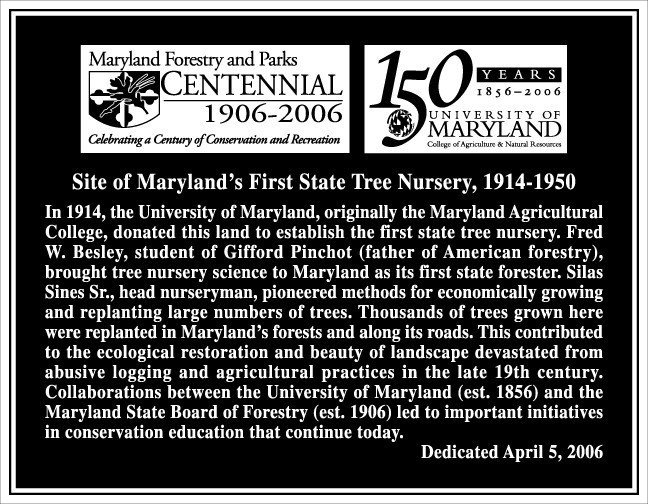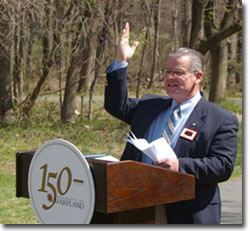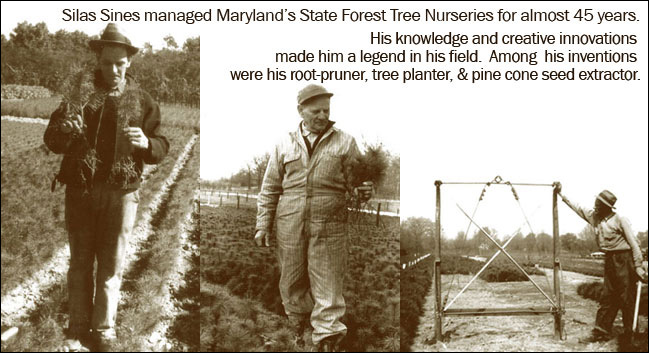Plaque Dedication and Ceremonial Tree Planting at the site of the original Maryland State Tree Nursery
College Park, Wednesday, April 5, 2006


Pictured (l to r): Kirk P. Rodgers, grandson of
Maryland's first State Forester; John S. Ayton, Maryland's 3rd State
Forest Tree Nursery Manager, Steve Koehn, Maryland State Forester; and
Silas Sines, Jr., son of Maryland's 2nd State Forest Tree Nursery Manager,
G. Silas Sines.
Dedication of the Plaque Honoring the First
State Tree Nursery
College Park, Maryland, April 5, 2006
Remarks by C. Ronald Franks, Secretary
Maryland Dept. of Natural Resources
 Good Afternoon. On behalf of Governor Robert L. Ehrlich and the Department of
Natural Resources, I am pleased to be here today to help you celebrate the 100th
anniversary of the legislation authorizing the first State Board of Forestry
here in College Park, and the 150th anniversary of the University of Maryland.
Good Afternoon. On behalf of Governor Robert L. Ehrlich and the Department of
Natural Resources, I am pleased to be here today to help you celebrate the 100th
anniversary of the legislation authorizing the first State Board of Forestry
here in College Park, and the 150th anniversary of the University of Maryland.
Today is also Arbor Day - a day we celebrate trees and recognize the many
valuable contributions and benefits they provide to society. What better place
to celebrate Arbor Day then here, where Maryland’s grand tradition for providing
trees to improve and enhance our public landscapes was born.
This Arbor Day is made a bit more special because by coincidence this Arbor Day
falls on the very day that marks the 100th anniversary of the signing of the
1906 Maryland Forest Conservation Act. This pioneering legislation created the
Maryland Forest Service and its sister agency, the Maryland Park Service. It
also spurred many of the century’s conservation initiatives, introducing
scientific forest management on both Maryland’s public and private lands.
The law was so innovative that it quickly moved Maryland to the forefront of the
national forest conservation movement. We were only the third state in the
country to initiate a statewide forest conservation program.
Of course, much of this would not have been possible without the foresight of
Fred W. Besley, Maryland’s first State Forester. Besley introduced the art and
science of establishing, growing and replanting healthy trees. Before coming to
Maryland, Fred Besley worked with the U.S. Forest Service under Gifford Pinchot.
Pinchot, the father of American Forestry, hand-picked Besley for the State
Forester position.
Besley brought with him the knowledge and experience he had acquired while
superintendent of a Nebraska tree nursery... and not a moment too soon. When he
accepted the State Forester position, Maryland’s forested landscape, like that
of much of the rest of the country, had been decimated. Only 20% of the forest
cover east of the Mississippi river remained as a result of 19th century
exploitive logging and agricultural practices.
So when Fred Besley arrived in 1906, he quickly got to work raising seedlings
that would go a long way toward restoring the ecological health of Maryland’s
forests and agricultural landscapes. Eight years later, the State Legislature
passed the Roadside Tree Law. One of the first of its kind, Maryland’s law would
later serve as a model imitated across the country. It authorized the state
forestry department to plant and protect trees along Maryland public right of
ways. It also enabled the state forestry division to establish a state tree
nursery.
That same year, the University of Maryland, known at the time as the Maryland
Agricultural College, donated the tract of land we stand upon today for this
purpose. The applied science of forestry conservation was launched from this
site here at College Park. It's hard to believe now but Route 1 was just a
bucolic country road when the nursery was established.
During his 36-year term as State Forester, Fred Besley established three state
forest tree nurseries, all on the property or near the University of Maryland at
College Park. With each passing year, productivity increased at the tree nursery
from thousands of trees produced annually to millions. Around 1944, the State
expanded operations to the Beltsville Experimental Tree Nursery.
I don’t think I need to remind you all the many benefits trees provide. They
produce oxygen that cleans the air. They supply shade that helps cool the
earth’s surface temperature and that of our streams and creeks. And just as
importantly, trees planted along stream sides remove nutrients from the soil,
absorb pollutants and reduce sedimentation.
As you probably know, restoring the Chesapeake Bay is the number one
environmental priority of both the Governor and myself. And any hope of
reversing the long-term decline to the Bay cannot be accomplished without a
total commitment on part of all parties involved to repairing our network of
forest buffers. All the work conducted here over the years illustrates one of
our favorite quotes at DNR, “The best time to plant a tree was 20 years ago. The
next best time is now.”
Congratulations to all here at the University of Maryland College of Agriculture
and Natural Resources and the Maryland Forest Service on a century of phenomenal
achievements. And thank you for being a tremendous part of our continued
forestry efforts.
- DNR Secretary C. Ronald Franks
Dedication of the Plaque Honoring the First
State Tree Nursery
College Park, Maryland, April 5, 2006
Remarks by Steve Koehn, State Forester
Greetings: What a day! For a forester, it doesn’t get much better than this!
It’s Arbor Day – Where we celebrate the values of trees.
It’s Founders day – where we are celebrating the founding of Maryland Forest
Service.
And what better place to celebrate than here at College Park --the site of
Maryland’s first state forest tree nursery…
Your presence here today proves that you understand the importance of forestry
and the value of conserving our natural resources.
Value of the Forest Tree Nursery
Perhaps this quote form Larry Maxim, Savage River State Forester, best captures
the significance of Maryland's State Forest Tree Nursery: "The State Forest tree
nursery symbolizes man's hope for the future. It is a testimony to man's love
for the forest and his desire to establish trees where there are none… The
Forest Tree Nursery epitomizes what forestry is all about - reestablishing and
maintaining the health of the forest."
Deplorable environmental conditions
I would like to add to what Secretary Franks said about the condition of the
forest 100 years ago to illustrate that we have come a long way in restoring the
health of the environment - and the role this Forest Tree Nursery played in it:
Exploitive logging and agricultural practices that occurred in the late 19th
century caused this deplorable environmental situation. It was a large scale
ecological disaster. The nation was alarmed that timber resources were running
out and would soon be depleted.
Perhaps, the passenger pigeon is the poster bird that symbolizes the overall
poor health of the forests back than; there were once billions of passenger
pigeons in the United States. When a flock flew overhead, they darkened the sky
for hours. The last surviving one was named Martha. She died at the Cincinnati
Zoo. The passenger pigeon went extinct in 1914, the same year this tree nursery
at College Park was established. The environment was hurting.
Dual beginnings of Forest Conservation and the
Automobile Age
It's important to remember that the beginnings of the American Forestry
Conservation movement coincided with the beginnings of the automobile age. Roads
were being constructed everywhere as more and more people bought cars. Very few
regulations were established to preserve the beauty of the landscape as seen
from the roads.
Kirk Rodgers, Fred W. Besley's grandson, who is present today, said that one of
the earliest and most vigorous efforts his grandfather undertook as a state
forester was to establish a state tree nursery. "He was particularly interested
in forest regeneration. He was ashamed with the way Maryland's roadsides looked.
He made this into a crusade."
G. Silas Sines
Since 1914 to present, only a handful of individuals have served as head
nurseryman of a Maryland State Tree nursery. Three of them are here today. Silas
Sines' son, Silas Sines, Jr. grew up on working at this tree nursery. He
actually ran the tree nursery for a year until his father, who was injured in a
serious accident, returned to work. So, three of the four nurserymen that headed
the tree nursery since 1914 are represented today. (Mr. Koehn introduces John
Ayton and Richard Garrett.)
We take great pride that there have been only ten state foresters over the
years. But I think it even more remarkable that there have been only four head
nurserymen since 1914. This group of men all have one thing in common - they
were extremely dedicated to their work. If time allowed, I could go on about the
great accomplishments of each nurseryman, but since it doesn’t let me just
mention one, Silas Sines.

From 1929 to 1974, about 45 years, Sines oversaw and guided the growth of state
tree nursery operations at College Park. Over time, the self-sufficient work
habits of Sines became legend. The employees he supervised respected and looked
up him. He was not above working in the field right along side his staff. Sines
was sought out by professional nurserymen and foresters for his insight,
knowledge and know-how about growing and transplanting trees and overall tree
nursery operations. They were amazed at Sines creative innovations, made even
more remarkable as Sines had very little formal education. They traveled long
distances to study his practices and photograph the tools and equipment he
designed such as his root-pruner, tree planter, and pine cone seed extractor.
Probably Sines greatest career achievement is that he pioneered methods for
economically growing and replanting large numbers of healthy trees. Because of
Sines, The Maryland State Forest Tree Nursery had a reputation among nurserymen
in the eastern United States for growing the best tree seedlings at the cheapest
price. Henry C. Buckingham, the third state forester, once told a group of
nurserymen that of all the trees grown at tree nurseries in the eastern United
States, Maryland's trees stood out like a "fly in buttermilk."
In 1950, the College Park State tree nursery was relocated to Harmans, Maryland
where it operated from 1950 to about 1995. Due to the construction of Route 100,
the Nursery was again relocated in 1996 to its present site near Preston,
Caroline County on the eastern Shore. It was named the John S. Ayton Forest Tree
Nursery, for the person most instrumental in its establishment.
Maryland Forestry Boards
I like to thank Steve Dorsey and the Prince George’s Forestry Board for
providing the White Oak to plant. The Maryland Forestry Boards have contributed
significantly to forestry in Maryland.
Established in 1943, The Maryland Forestry Boards were the first forestry
organization of their kind east of Mississippi River to promote sound forestry
practices on private property.
I also like to thank Dr. Kangas, and Kimberly Monahan, Dr. Kangas’s assistant,
for all their hard work that made this memorable program possible today.
The Maryland Forest Service’s adopted Centennial Slogan, is “Celebrating Our
Past, Creating Our Future.” The University of Maryland has been an integral part
of the legacy of Maryland Forest Service and has contributed greatly to forest
conservation. We celebrate our shared past together. With the agreement* being
signed today, we look forward to continuing our long and productive
relationship, together creating a future in forest conservation that will be
celebrated 100 years from now during the Maryland Forest Service's
bi-centennial.
- Steve Koehn, Maryland State Forester
* The agreement referred to was a Letter of Intent between
the Maryland Department of Natural Resources and the University of Maryland
College of Agriculture & Natural Resources, which reads as follows:
Letter of Intent
The University of Maryland, College of Agriculture and Natural Resources
and the Maryland Department of Natural Resources-Forest Service has a long
standing relationship. This relationship began 100 years ago with the
establishment of the first state tree nursery and continues today with
financial support for a shared position focusing on forest landowner
education.
Both the College of Agriculture and Natural Resources and the Department
of Natural Resources want to expand their relationship into the future.
It is the intent of this future relationship to include adjunct faculty
opportunities for DNR employees, internship opportunities for College of
Agriculture & Natural Resource students at DNR, and enhanced research and
extension activities.
A detailed document will be developed to formalize this relationship by a
team of representatives from both organizations.
Signed on April 5, 2006
by:
Dr. Cheng-i Wei
Dean, College of Agriculture & Natural Resources
Director, Maryland Cooperative Extension
and
C. Ronald Franks
Secretary, Maryland Department of Natural Resources
Since 1914, there have been only four
Maryland State Forest Tree Nursery Managers
Mr. Klein - Little is known of the State's first tree nursery manager.
State Forester Fred W. Besley referred to him only as Mr. Klein.
Silas Sines - A native of Garrett County
who oversaw and guided the growth and operations of the state forest tree
nursery from 1929-1974 - almost 45 years.
John S. Ayton - A former nursery supervisor at the Buckingham State
Forest Tree Nursery, John was instrumental in the design and construction, from
buildings to grounds and operations, of the present-day nursery which bears his
name. John began his career with DNR’s Forest Service in 1961 and retired
in 1996, one year after the John S. Ayton State Forest Tree Nursery was
completed.
Richard Garrett - Mr. Garrett became the John S. Ayton State Tree Nursery Manager in
1996. Richard has been with the DNR Forest Service since 1984.